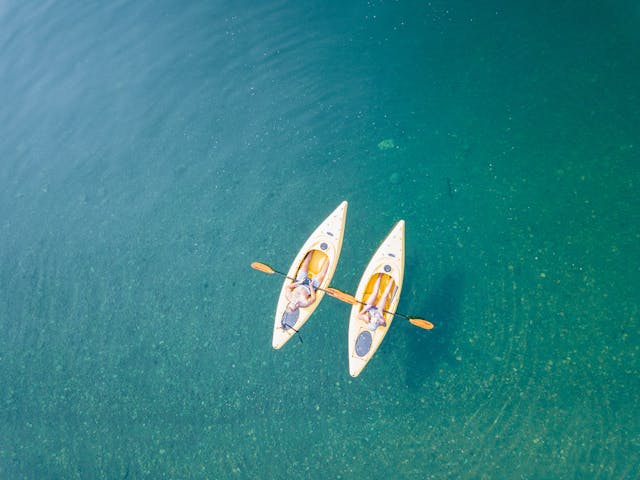Kayaking and Canoeing: Exploring Waterways and Safety Tips
Few activities bring you closer to nature than paddling along a serene river, gliding across a glassy lake, or navigating the thrills of white-water rapids. Kayaking and canoeing offer the perfect combination of adventure, exercise, and tranquility. Whether you're a seasoned paddler or a beginner, exploring waterways opens up a world of scenic beauty and peaceful escape. Let’s delve into the essentials of kayaking and canoeing, along with crucial safety tips for a safe and enjoyable experience.

Choosing Between Kayaking and Canoeing
While kayaking and canoeing share similarities, they differ in equipment, techniques, and experiences.
-
Kayaking:
In a kayak, you sit with your legs extended inside a closed or open cockpit, using a double-bladed paddle. Kayaks are ideal for faster movement, exploring open waters, or tackling challenging rapids. Popular types include: -
Recreational kayaks for calm waters.
-
Touring kayaks for longer trips and open lakes.
-
Whitewater kayaks for navigating rapids.
-
Canoeing:
Canoes are open boats where you sit or kneel and use a single-bladed paddle. They’re great for carrying gear on camping trips or paddling in calm rivers. Canoes offer a more relaxed pace, making them ideal for group adventures or family outings.
Each option has its charm—choose one based on your goals, waterway, and skill level.
Essential Gear for Paddling Adventures
Before hitting the water, make sure you’re equipped with the right gear:
-
Life Jacket (PFD): A properly fitted personal flotation device is non-negotiable.
-
Paddles: Choose the appropriate paddle type for kayaking or canoeing.
-
Dry Bag: Keep essentials like phones, snacks, and first-aid supplies safe from water.
-
Waterproof Clothing: Dress appropriately for the weather and water conditions. Layers and quick-drying materials are best.
-
Helmet: For whitewater kayaking or challenging conditions, a helmet is a must.
-
Whistle: Essential for signaling in case of emergencies.
Optional extras like a waterproof map, GPS, or sunscreen can enhance your experience and comfort.
Exploring Scenic Waterways
The beauty of kayaking and canoeing is the variety of waterways you can explore. Some popular options include:
-
Calm Lakes and Reservoirs: Ideal for beginners, these offer gentle waters and scenic views.
-
Rivers: From lazy floats to adrenaline-pumping rapids, rivers cater to all skill levels.
-
Coastal Areas: Sea kayaking allows you to explore shorelines, islands, and marine wildlife.
-
Wetlands: Paddle through mangroves or marshes to immerse yourself in unique ecosystems.
Research local waterways or plan trips to famous paddling destinations like the Boundary Waters in Minnesota or Florida’s Everglades for unforgettable experiences.
Paddling Techniques and Tips
Understanding proper paddling techniques makes your time on the water more efficient and enjoyable:
-
Kayaking Tips:
-
Maintain an upright posture and engage your core for power.
-
Use your whole body, not just your arms, for smooth and efficient strokes.
-
Learn to brace and roll for stability in rough waters.
-
Canoeing Tips:
-
Coordinate with your paddling partner for balance and direction.
-
Practice J-strokes and cross-draw strokes for better control.
-
Keep your weight centered and low to avoid tipping.
Taking a beginner class or practicing in calm waters can help you master these skills.
Safety First: Staying Secure on the Water
Safety is paramount when kayaking or canoeing. Follow these tips to ensure a safe adventure:
-
Wear a Life Jacket: Always wear your PFD, regardless of your swimming ability.
-
Check the Weather: Avoid paddling in high winds, storms, or rough waters.
-
Know Your Limits: Choose a waterway and activity level suited to your skills.
-
Stay Hydrated and Nourished: Bring plenty of water and snacks, especially on longer trips.
-
Practice Rescue Skills: Learn how to re-enter a capsized kayak or rescue a fellow paddler.
-
File a Float Plan: Let someone know your route and expected return time.
-
Stay Visible: Use bright clothing or lights to remain visible to other watercraft.

Environmental Responsibility: Leave No Trace
Paddling adventures often take you through pristine natural environments. Protect these spaces by practicing Leave No Trace principles:
-
Dispose of waste properly.
-
Avoid disturbing wildlife or damaging plants.
-
Stick to established routes and access points.
-
Use eco-friendly products to minimize pollution.
Respecting nature ensures that these waterways remain beautiful for future paddlers.
Why Kayaking and Canoeing Are Worth It
Beyond their recreational appeal, kayaking and canoeing offer physical and mental health benefits. Paddling builds strength, improves cardiovascular health, and relieves stress. The rhythmic motion of paddling combined with the tranquility of nature creates a meditative experience that rejuvenates the soul.
Whether you’re exploring a calm lake at sunrise or conquering the thrill of whitewater rapids, kayaking and canoeing provide unforgettable moments of connection—with both nature and yourself. So grab a paddle, hit the water, and let the adventure begin!





























